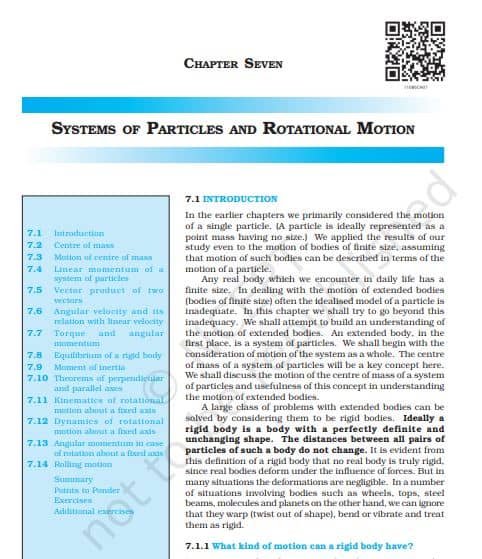‘NCERT Solutions for Class 11 Physics Chapter 7‘ PDF Quick download link is given at the bottom of this article. You can see the PDF demo, size of the PDF, page numbers, and direct download Free PDF of ‘Ncert Class 11 Physics Chapter 7 Exercise Solution’ using the download button.
NCERT Class 11 Physics Textbook Chapter 7 With Answer PDF Free Download

Chapter 7: Systems of Particles and Rotational Motion
7.1 Introduction
In the earlier chapters, we primarily considered the motion of a single particle. (A particle is ideally represented as a point mass having no size.)
We applied the results of our study even to the motion of bodies of finite size, assuming that the motion of such bodies can be described in terms of the motion of a particle.
Any real body which we encounter in daily life has a finite size. In dealing with the motion of extended bodies (bodies of finite size) often the idealized model of a particle is inadequate.
In this chapter, we shall try to go beyond this inadequacy. We shall attempt to build an understanding of the motion of extended bodies.
An extended body, in the first place, is a system of particles. We shall begin with the consideration of the motion of the system as a whole.
The center of mass of a system of particles will be a key concept here.
We shall discuss the motion of the center of mass of a system of particles and the usefulness of this concept in understanding the motion of extended bodies.
A large class of problems with extended bodies can be solved by considering them to be rigid bodies. Ideally, a rigid body is a body with a perfectly definite and unchanging shape.
The distances between all pairs of particles of such a body do not change.
It is evident from this definition of a rigid body that no real body is truly rigid, since real bodies deform under the influence of forces. But in many situations the deformations are negligible.
In a number of situations involving bodies such as wheels, tops, steel beams, molecules, and planets, on the other hand, we can ignore that they warp (twist out of shape), bend, or vibrate and treat them as rigid.
7.1.1 What kind of motion can a rigid body have?
Let us try to explore this question by taking some examples of the motion of rigid bodies. Let us begin with a rectangular block sliding down an inclined plane without any sidewise movement.
The block is taken as a rigid body. Its motion down the plane is such that all the particles of the body are moving together, i.e. they have the same velocity at any instant of time. The rigid body here is in pure translational motion.
| Author | NCERT |
| Language | English |
| No. of Pages | 42 |
| PDF Size | 4.2 MB |
| Category | Physics |
| Source/Credits | ncert.nic.in |
NCERT Solutions Class 11 Physics Chapter 7 Systems of Particles and Rotational Motion
Q1. Give the location of the centre of mass of a (i) sphere, (ii) cylinder, (iii) ring, and (iv) cube, each of uniform mass density. Does the centre of mass of a body necessarily lie inside the body?
Ans.
All the given structures are symmetric bodies having a very uniform mass density. Thus, for all the above bodies their center of mass will lie in their geometric centres.
It is not always necessary for a body’s center of mass to lie inside it, for example, the center of mass of a circular ring is at its center.
Q3. A child sits stationary at one end of a long trolley moving uniformly with a speed V on a smooth horizontal floor. If the child gets up and runs about on the trolley in any manner, what is the speed of the CM of the (trolley + child) system?
Ans.
The child and the trolley constitute a single system and the child moving inside the trolley is a purely internal motion. Since there is no external force on the system the velocity of the center of mass of the system will not change.
Q12. A solid cylinder of mass 20 kg rotates about its axis with angular speed 100 rad s-1. The radius of the cylinder is 0.25 m. What is the kinetic energy associated with the rotation of the cylinder? What is the magnitude of angular momentum of the cylinder about its axis?
Ans.
Given,
Mass of the cylinder, m = 20 kg
Angular speed, ω = 100 rad s–1
Radius of the cylinder, r = 0.25 m
The moment of inertia of the solid cylinder:
I = mr2 / 2
= (1/2) × 20 × (0.25)2
= 0.625 kg m2
( a ) ∴ Kinetic energy = (1/2) I ω2
= (1/2) × 0.625 × (100)2 =3125 J
( b )∴Angular momentum, L = Iω
= 0.625× 100
= 62. 5 Js
Systems of Particles and Rotational Motion Textbook With Solutions PDF Free Download
